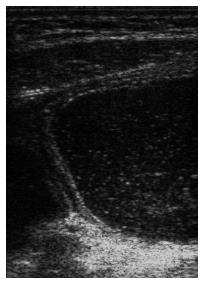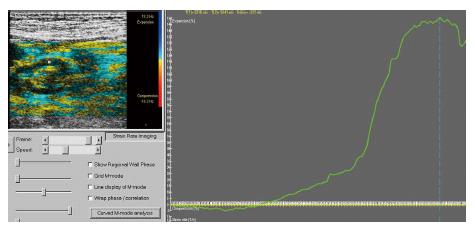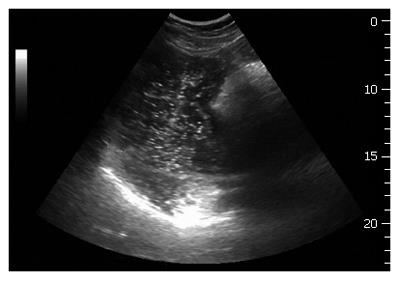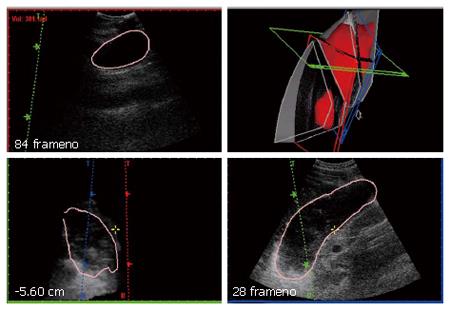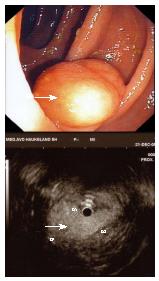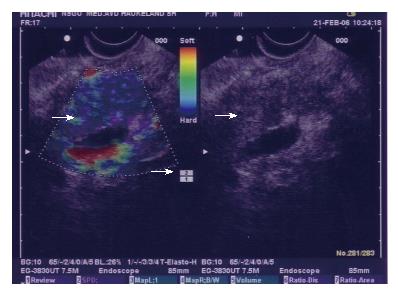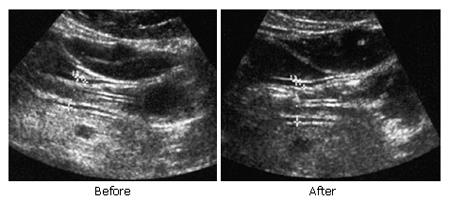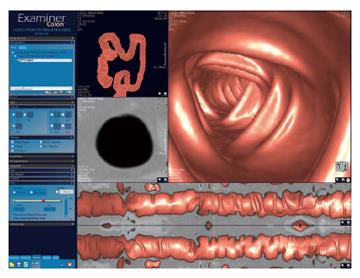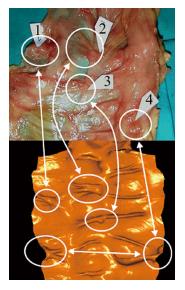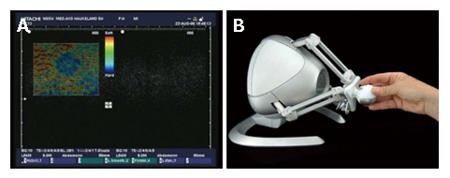Copyright
©2007 Baishideng Publishing Group Co.
World J Gastroenterol. Mar 7, 2007; 13(9): 1408-1421
Published online Mar 7, 2007. doi: 10.3748/wjg.v13.i9.1408
Published online Mar 7, 2007. doi: 10.3748/wjg.v13.i9.1408
Figure 1 Ultrasonogram of the fluid-filled gastric antrum showing the different wall layers and a propagating contraction wave that occludes the lumen.
Figure 2 These graphics outline the relative radial strain of the circular muscle layer of the antral wall.
The exact sampling point in the gastric wall is denoted with a red marker in the color Doppler ultrasonogram of the left panel. In the right panel, the positive strain curve with a maximum of 150% radial elongation of the muscle layer is demonstrated.
Figure 3 An oblique frontal section applied for ultrasound scanning of the proximal stomach.
The top margin of the fundus is shown as a white line in the bottom of the image. A proximal gastric diameter is outlined in the frontal section by tracing normally to the longitudinal axis of the proximal stomach, thus indicating the size of the proximal stomach.
Figure 4 A 3D reconstruction of the total stomach volume (red) in the upper left panel.
The acquisition is based on magnetic scanhead tracking. Three orthogonal orientation planes are shown in red, green and blue. The upper left panel is a volume reconstruction window where manual outlining of the structures are made.
Figure 5 Small bowel loops (arrows) imaged from the stomach with an echoendoscope.
Liq-uid within the gastric lumen gives an excellent acoustic window.
Figure 6 Endoscopic image of a tumour in the colon (arrow, top).
An ultrasound miniprobe is used to “palpate” the relatively soft echo-rich tumour (arrow) which is a lipoma.
Figure 7 ES-elastography (colour coded, left) in chronic pancreatitis displaying hard (blue) and softer (green) areas (left, large arrow).
Corresponding B-image (right, arrow). Transducer pressure is indicated by a scale (small arrow).
Figure 8 Endosonographic changes i.
e. any resolvable wall thickening of the duodenum, contraction or new echogenic layer) were observed in many patients with food hypersensitivity. Increased mucosal thickness associated with a new echogenic layer was seen in two patients[82].
Figure 9 The sonographic features; wall thickness and diameter of the duodenal bulb and jejunum, peristalsis activity, and luminal fluid were recorded before and during allergen challenge by external ultrasound.
The ultrasonographic view of the duodenal bulb shows wall thickening and increased diameter in response to provocation[83].
Figure 10 Example of a colonoscopy layout in a 3D medical workstation 3Dnet Examiner (Copyright Biotronics3D Ltd, Used by permission).
Figure 11 Comparison between real colon dissection and the resulting visualization of colon unfolding technique (Copyright Anna Vilanova, Used by permission).
Figure 12 Screenshot of current two-dimensional ultrasound elastography visualization (A) and the Novint Falcon 3D haptic controller (B).
- Citation: Gilja OH, Hatlebakk JG, Ødegaard S, Berstad A, Viola I, Giertsen C, Hausken T, Gregersen H. Advanced imaging and visualization in gastrointestinal disorders. World J Gastroenterol 2007; 13(9): 1408-1421
- URL: https://www.wjgnet.com/1007-9327/full/v13/i9/1408.htm
- DOI: https://dx.doi.org/10.3748/wjg.v13.i9.1408









